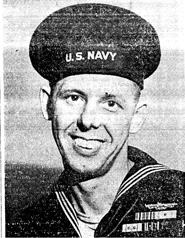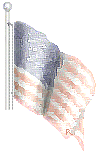VETERAN OF SUBMARINE WARFARE
Sioux Cityan Tells of Hunting Axis Ships in Two Oceanside
“Three Jap cruisers located our submarine off the island of Formosa and started dropping depth charges on and around. They kept it up for 12 consecutive hours, hemming us in so that it was impossible to get away. Our lights were out and the only thing we could do was wait there in the dark.”
Despite that harrowing experience, Charles Guiney, electrician’s mate first class, states that a submarine is the safest place to be during a naval battle. At the end of his leave with his wife’s parents, Mr. and Mrs. A. W. Singer, 205 W. Third street, Guiney will report to a submarine base on the Atlantic coast and expects to be assigned to a new ship.
In Navy Six Years
Guiney has been in the Navy six years and has spent five of them on submarines. He was base in the Panama Canal Zone at the time of the Jap attack on Pearl Harbor and subsequently saw extensive service in both the Atlantic and the Pacific.
His submarine was assigned to help the first American landings at Casablanca at the beginning of the African campaign. Later, in a daylight submarine attack in the Bay of Biscayne, he saw three nazi destroyers and one merchant ship sent to the bottom by American torpedoes.
“That was one of the few sea fights which I saw from start to finish,” he says. “Most of the others took place at night or under conditions of poor visibility.”
On Pacific Patrol
The same submarine later was based near Glasgow, Scotland, for about two years and was assigned to patrol duty in the North Sea and along the Norwegian coast. Following that assignment, Guiney came back to this country and a new ship. Then began a long tour of patrol duty in the South Pacific.
“We were based at Honolulu,” he says, “but we patrolled the entire South Pacific. We were close enough to Tokyo to see the mountains in the background through our periscope. Our territory included Formosa, Nagasaki, Leyte, the China coast, Guam and Saipan.
“Most of it was routine patrol work, but now and then we had a chance to sink a Jap ship. There’s a lot of satisfaction in a job like that, and it more than makes up for the monotonous days of uneventful duty.”
American submarines frequently are under water for as long as 20 hours at a stretch, according to Guiney. He explains that during his patrol duty off the coasts of Norway and Sweden it frequently was necessary to stay submerged that long because of the visibility provided by the midnight sun.
“There are few hardships aboard a submarine,” he states. “Our modern subs carry two large air conditioning units and two auxiliaries. There is always plenty of fresh air at a comfortable temperature.”
Guiney was born and reared in Sioux City. He attended Webster, West junior and Central high schools. He is the son of Mrs. Katharine Guiney. He married Miss Verda Singer here in December, 1943.
Source: The Sioux City Journal, February 11, 1945 (photo included)
![]()

